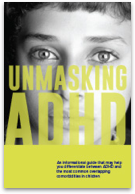DIAGNOSING ADHD
Clinical guidelines for recognizing and diagnosing ADHD
While you may be familiar with the ADHD diagnostic criteria, there are new SDBP guidelines to help in diagnosing complex ADHD.1
Diagnostic Criteria
Finding an ADHD diagnosis
To be diagnosed with one of three types of ADHD, individuals must meet the following criteria, adapted from DSM-5™ 2
Six or more symptoms of inattention and/or hyperactivity/impulsivity must have persisted for at least six months to a degree that is inconsistent with developmental level and that negatively impacts directly on social and academic/occupational activities. For older adolescents and adults (age 17 and older), at least five symptoms are required.2
ADHD symptoms of inattention2
- Makes careless mistakes/lacks attention to detail
- Lacks sustained attention in tasks or play activities
- Poor listener, even in the absence of obvious distraction
- Fails to follow through on tasks and instructions
- Difficulty with organization, time management, and deadlines
- Avoids tasks requiring sustained mental effort
- Loses things necessary for tasks or activities
- Easily distracted (including unrelated thoughts)
- Forgetful in daily activities
ADHD symptoms of hyperactivity/impulsivity2
- Fidgets, taps hands, or squirms in seat
- Leaves seat in situations when remaining seated is expected
- Excessive running/climbing, or feelings of restlessness
- Difficulty with quiet, leisure activities
- Often “on-the-go”; acting as if “driven by a motor”
- Excessive talking
- Blurts out answers before questions are even completed
- Difficulty waiting turn
- Interrupts or intrudes on others
Combined (inattentive/hyperactive-impulsive)
Shows symptoms of both inattentive and hyperactive-compulsive ADHD2
Several ADHD symptoms must be present in 2 or more settings2
In order to diagnose ADHD, symptoms must be persistent; confirmation of substantially impacting symptoms across settings typically cannot be accurately assessed without consulting observers who have seen the individual in the setting.2
Symptoms typically vary depending on setting/context. Below you will find some examples of how ADHD may affect children and adolescents at home, at school, and in social settings2:
At home2
- Is forgetful doing chores
- Has difficulty keeping materials and belongings in order
- Is reluctant to engage in tasks that require sustained mental effort such as homework
At school2
- Does not follow through on instructions and fails to complete assignments
- Overlooks or misses details in homework or schoolwork
- Often squirms in seat and leaves seat in classroom inappropriately
In social settings2
- Does not seem to listen when spoken to directly
- Cannot wait for turn in conversations
- May intrude into or take over what others are doing during play activities
These are not the complete diagnostic criteria
Please see DSM-5 for full diagnostic criteria. It is important to note that diagnosis should be based on a complete history of the patient.
SDBP Guideline
SDBP clinical practice guideline represents a new paradigm in complex ADHD management1
In January 2020, the Society for Developmental and Behavioral Pediatrics (SDBP), a panel of developmental-behavioral pediatricians, psychologists, and nurse practitioners, introduced the first-ever clinical practice guideline for patients with complex ADHD.1
The guideline was developed specifically to help guide diagnosis and treatment decisions in complex ADHD1:
- It provides a broader perspective on conditions that define complex ADHD:
- Neurodevelopmental disorders
- Mental health disorders
- Socioeconomic factors
- It also helps identify current gaps in disease research and management1

“The SDBP guideline is intended to complement the 2019 AAP guideline and to be useful for clinicians from multiple disciplines, as well as for educational professionals who have specialized training and/or expertise that equips them to provide care for children and adolescents with complex ADHD.”
–Frank Lopez, MD3
KEY RECOMMENDATIONS OF THE SDBP
Recommendation
Development of a multimodal treatment plan for children and adolescents with suspected complex ADHD initiated by clinicians with specialized expertise/training
Strength of Evidence
Grade B—Strong Recommendation
Recommendation
Use of an evidence-based approach to assess for comorbid conditions, including their severity and associated functional impairment
Strength of Evidence
Grade B—Strong Recommendation
Recommendation
Psychoeducation to address all functional domains (behavioral, social, and academic)
Strength of Evidence
Grade B—Strong Recommendation
Recommendation
Treatment of complex ADHD focused not only on symptom management, but on prevention of adverse outcomes (eg, depression and anxiety)
Strength of Evidence
Grade C to B—Recommendation to Strong Recommendation
Recommendation
Monitoring of patients throughout their lives, with emphasis on key developmental periods (eg, school transitions), given chronic nature of ADHD
Strength of Evidence
Grade B—Strong Recommendation
“We need a paradigm shift, and it is my hope that the Guideline and the continued efforts of everyone who cares for and about children and adolescents with ADHD will help to make this change for the benefit of children and their families.”4
– William J Barbaresi, MD
How will this new SDBP guideline inform your practice?
The SDBP guideline underscores that assessment and treatment of children with complex ADHD require a multimodal approach from multiple systems (eg, healthcare, education, etc) to ensure the best possible outcomes.1
Telehealth: Diagnosing From a Distance
Advances in telehealth technology and changes in regulations governing personal health information (PHI) have made it possible to diagnose and treat patients even when not in the same room.
Telemedicine in ADHD
While face-to-face visits are often preferred, especially for initial evaluations, telemedicine is emerging as a viable option for ADHD consults:
- Telemedicine has been successfully employed in several medical specialties, with favorable patient outcomes5
- A growing body of evidence suggests that telemedicine has a significant potential to expand the delivery of clinical services to patients and families with ADHD in a cost-effective manner5
Key Takeaways
- Symptoms of ADHD vary depending on setting and context2
- 2020 SDBP Guideline introduced to help diagnosis and treatment decisions3
- Telemedicine is emerging as an option for ADHD consults5
UP NEXT:
Stay in the know and access an exclusive ADHD resource

“Unmasking ADHD” can help you differentiate between ADHD and the most common overlapping comorbidities in children.
UP NEXT:
REFERENCES
- Barbaresi WJ, Campbell L, DiekrogerEA, et al. The Society for Developmental and Behavioral Pediatrics Clinical Practice Guidelines for the Assessment and Treatment of Children and Adolescents With Complex Attention-Deficit/HyperactivityDisorder: Process of Care Algorithms. J Dev Behav Pediatr. 2020;41 Suppl 2S:S58-S74.
- American Psychiatric Association. Diagnostic and Statistical Manual of Mental Disorders. 5th ed. Washington, DC: American Psychiatric Publishing; 2013.
- Data on file. Supernus Pharmaceuticals.
- Barbaresi WJ. The SDBP Complex ADHD Clinical Practice Guideline: It’s About Time. J Dev Behav Pediatr. 2020;41 Suppl 2S:S33–S34.
- Spencer T, Noyes E, Biederman J. Telemedicine in the management of ADHD: literature review of telemedicine in ADHD. J Atten Disord. 2020;24(1):3-9.



